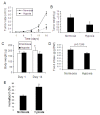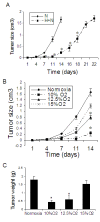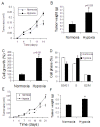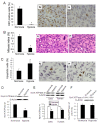Long-term exposure to hypoxia inhibits tumor progression of lung cancer in rats and mice
- PMID: 21812995
- PMCID: PMC3199866
- DOI: 10.1186/1471-2407-11-331
Long-term exposure to hypoxia inhibits tumor progression of lung cancer in rats and mice
Abstract
Background: Hypoxia has been identified as a major negative factor for tumor progression in clinical observations and in animal studies. However, the precise role of hypoxia in tumor progression has not been fully explained. In this study, we extensively investigated the effect of long-term exposure to hypoxia on tumor progression in vivo.
Methods: Rats bearing transplanted tumors consisting of A549 human lung cancer cells (lung cancer tumor) were exposed to hypoxia for different durations and different levels of oxygen. The tumor growth and metastasis were evaluated. We also treated A549 lung cancer cells (A549 cells) with chronic hypoxia and then implanted the hypoxia-pretreated cancer cells into mice. The effect of exposure to hypoxia on metastasis of Lewis lung carcinoma in mice was also investigated.
Results: We found that long-term exposure to hypoxia a) significantly inhibited lung cancer tumor growth in xenograft and orthotopic models in rats, b) significantly reduced lymphatic metastasis of the lung cancer in rats and decreased lung metastasis of Lewis lung carcinoma in mice, c) reduced lung cancer cell proliferation and cell cycle progression in vitro, d) decreased growth of the tumors from hypoxia-pretreated A549 cells, e) decreased Na+-K+ ATPase α1 expression in hypoxic lung cancer tumors, and f) increased expression of hypoxia inducible factors (HIF1α and HIF2α) but decreased microvessel density in the lung cancer tumors. In contrast to lung cancer, the growth of tumor from HCT116 human colon cancer cells (colon cancer tumor) was a) significantly enhanced in the same hypoxia conditions, accompanied by b) no significant change in expression of Na+-K+ ATPase α1, c) increased HIF1α expression (no HIF2α was detected) and d) increased microvessel density in the tumor tissues.
Conclusions: This study demonstrated that long-term exposure to hypoxia repressed tumor progression of the lung cancer from A549 cells and that decreased expression of Na+-K+ ATPase was involved in hypoxic inhibition of tumor progression. The results from this study provide new insights into the role of hypoxia in tumor progression and therapeutic strategies for cancer treatment.
Figures









Similar articles
-
Antisense oligonucleotide of hypoxia-inducible factor-1alpha suppresses growth and tumorigenicity of lung cancer cells A549.J Huazhong Univ Sci Technolog Med Sci. 2006;26(4):448-50. doi: 10.1007/s11596-006-0418-6. J Huazhong Univ Sci Technolog Med Sci. 2006. PMID: 17120745
-
Effect of connective tissue growth factor on hypoxia-inducible factor 1alpha degradation and tumor angiogenesis.J Natl Cancer Inst. 2006 Jul 19;98(14):984-95. doi: 10.1093/jnci/djj242. J Natl Cancer Inst. 2006. PMID: 16849681
-
The transmembrane adaptor Cbp/PAG1 controls the malignant potential of human non-small cell lung cancers that have c-src upregulation.Mol Cancer Res. 2011 Jan;9(1):103-14. doi: 10.1158/1541-7786.MCR-10-0340. Epub 2010 Dec 14. Mol Cancer Res. 2011. PMID: 21156787
-
The tumour hypoxia induced non-coding transcriptome.Mol Aspects Med. 2016 Feb-Mar;47-48:35-53. doi: 10.1016/j.mam.2016.01.003. Epub 2016 Jan 21. Mol Aspects Med. 2016. PMID: 26806607 Review.
-
Role of hypoxia‑inducible factor‑2α in lung cancer (Review).Oncol Rep. 2021 May;45(5):57. doi: 10.3892/or.2021.8008. Epub 2021 Mar 24. Oncol Rep. 2021. PMID: 33760175 Review.
Cited by
-
A facile in vitro platform to study cancer cell dormancy under hypoxic microenvironments using CoCl2.J Biol Eng. 2018 Aug 3;12:12. doi: 10.1186/s13036-018-0106-7. eCollection 2018. J Biol Eng. 2018. PMID: 30127847 Free PMC article.
-
Bladder cancer cell lines adapt their aggressiveness profile to oxygen tension.Oncol Lett. 2022 May 20;24(1):220. doi: 10.3892/ol.2022.13341. eCollection 2022 Jul. Oncol Lett. 2022. PMID: 35720486 Free PMC article.
-
Alterations of tumor microenvironment by carbon monoxide impedes lung cancer growth.Oncotarget. 2016 Apr 26;7(17):23919-32. doi: 10.18632/oncotarget.8081. Oncotarget. 2016. PMID: 26993595 Free PMC article.
-
Cell type-dependent HIF1 α-mediated effects of hypoxia on proliferation, migration and metastatic potential of human tumor cells.Oncotarget. 2017 Jul 4;8(27):44498-44510. doi: 10.18632/oncotarget.17806. Oncotarget. 2017. PMID: 28562340 Free PMC article.
-
Hypoxia-inducible factor-targeting prodrug TOP3 combined with gemcitabine or TS-1 improves pancreatic cancer survival in an orthotopic model.Cancer Sci. 2016 Aug;107(8):1151-8. doi: 10.1111/cas.12982. Epub 2016 Jul 21. Cancer Sci. 2016. PMID: 27270607 Free PMC article.
References
Publication types
MeSH terms
Substances
Grants and funding
LinkOut - more resources
Full Text Sources
Medical

